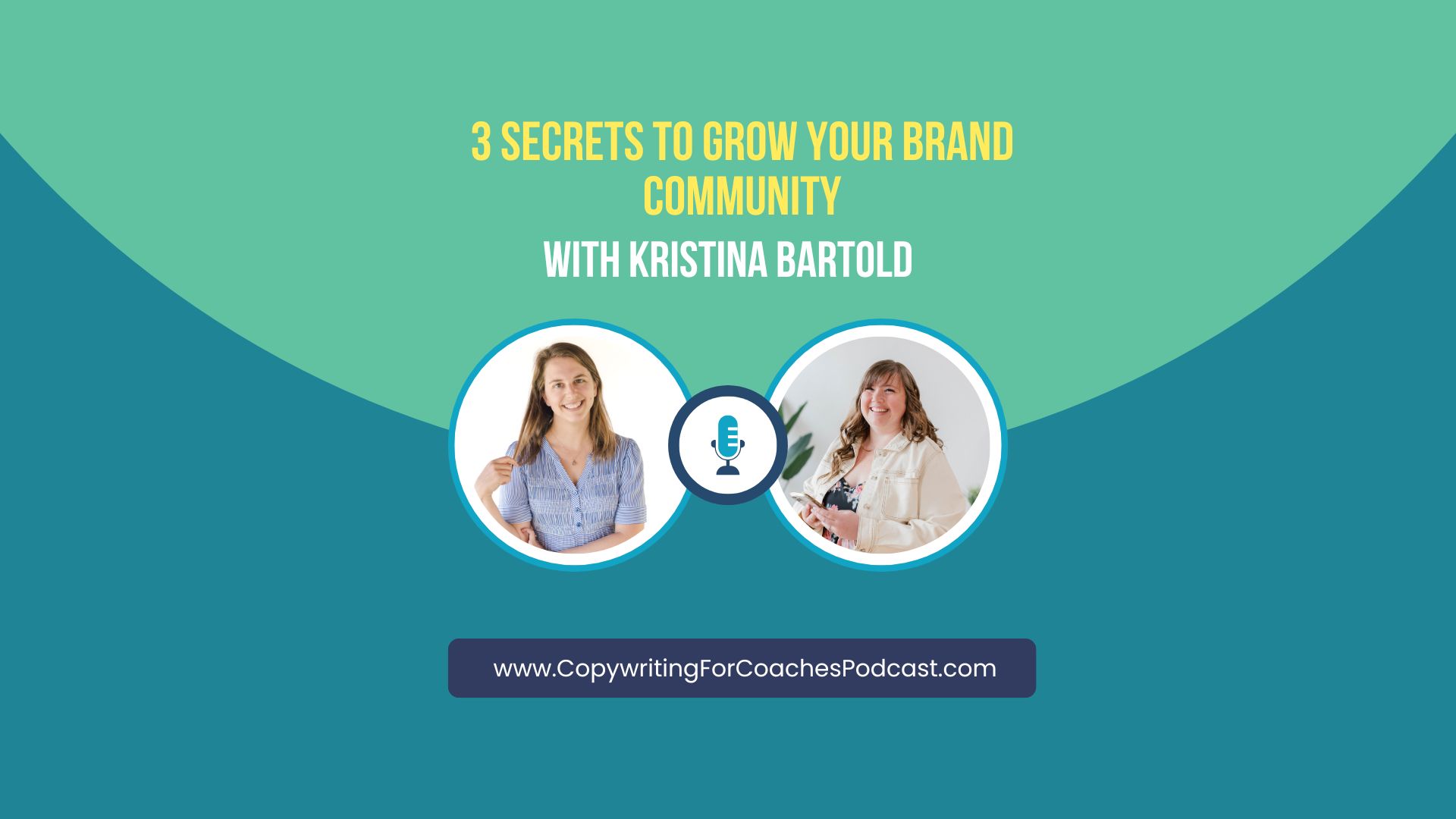Copywriting becomes so much easier once you have done this one thing…
And that is foundational brand messaging for coaches and brand identity work to confidently know who you are, what you stand for, and what you are here to do.
Understanding brand strategy is a natural prerequisite to copywriting. That’s why I interviewed 11 different brand strategists (connect with them in the show notes!) for this 3-part series to gather a well-rounded perspective on how to amplify your brand message. Each of these strategists, while sharing a common goal, approaches their work from unique angles, enriching our conversation with depth and diversity.
This episode uncovers how you can show up online authentically and the strategy behind it all. We’re getting brand strategists’ takes on how they integrate this and help their clients show up true to themselves. You’re getting both the copywriter and brand strategist perspective.
I wanted to have this conversation because positioning and messaging are where brand strategists and copywriters converge. That’s where we overlap. Today, we’ll explore how to refine and master your authentic brand message—and the top 10 mistakes to avoid!
Brand Authenticity At Every Stage Of Business
Your brand is the foundation of everything in your business. If it’s not authentic, you will be on the fast track to burn out. It’s about more than just colors and fonts; those are the final touches in the branding process. Without a streamlined and clear brand that you are confident in, your lack of coherence will reflect in everything you do.
To build an authentic brand, you need to start with a solid foundation—your vision, values, voice, and offers. These elements lie beneath the surface, much like the bulk of an iceberg, and they form the core of your brand’s authenticity. And that’s the bulk of our conversation today. What’s beneath the surface? What’s that 90% of the iceberg that we don’t see but holds the power to sink the Titanic? Without this clarity, your brand may fail to represent you accurately or attract the right audience.
Many businesses find themselves rebranding because their current brand no longer aligns with their values or fails to represent them properly. This is common among established businesses developing legacy brands, such as an author who, after writing a New York Times bestseller, needs to elevate their brand to be seen as a thought leader.
With that said, your brand is a living, breathing entity that grows and changes (because YOU are constantly growing and changing too—and that’s a good thing!). As your business evolves, so does your target market, which is a positive sign of growth.
Check Your Brand’s Effectiveness With The Cold Leads First Approach
An authentic brand helps you stand out and convert cold leads effectively. (This is a great approach, from Jasmine Haitalani of High Flier Powerhouse). You don’t get to “cheat” with people who already know and love you. You know your brand is working for you when people who have never heard of you before come to know, like, and trust the real you—and do so quickly.
Your brand shapes everything you do and is the driving force behind your decisions. It’s about the impression you make, the emotional reaction you evoke, and the invitation you extend to your audience. If others align with your brand, they will stand with you.
Authenticity can be polarizing, but it doesn’t have to be aggressive. Many people run businesses without realizing they have a brand. A significant part of your brand is the trust between your company and your clients, regardless of your visual identity.
Your brand is about how people are going to perceive your identity
The feeling your brand evokes, the set messaging, and the overall idea around your business are vital. Areanna Arclese noted that, from a personal brand perspective, your brand is about how people are going to perceive your identity. If you are uncertain of who you are, that will come across in your branding.
That is why we as business owners have to constantly be doing the inner work and the personal development. That’s why it’s essential to build a brand that looks, feels, and communicates intentionally.
When you have clarity on these foundational elements, creating assets such as your website, social media presence, and logos becomes much easier. Without this clarity, your brand may fail to represent you accurately or attract the right audience. This is the deep work that you begin with a brand strategist and continue to do with a great copywriter.
Sound Like Every Coach Out There? Your Brand Authenticity Matters Most
Effective brand messaging for coaches is about doing the work that many avoid. Businesses often rush for quick results using shiny objects and tactics without slowing down to get their branding right. The branding process can be deep and I love how Tiffany Neuman from Your Legacy Brand described her process as deep, often spiritual, and identity-shifting. When done right, the results are astounding. That is the level of depth we are talking about here.
Authenticity is key. Especially in this digital world that feels so noisy, walking your talk sets you apart. The first step is knowing who you’re talking to—you cannot address everyone. The purpose is to speak directly to someone. Fear of specificity often stems from the worry of weeding out potential clients, but specificity makes them feel truly seen and known—more so than general language ever could.
The second step is knowing what to say, ensuring your offer aligns with your audience’s needs in a way that is clear, specific, and concise.
Effective brand messaging for coaches follows the ROI principle:
– Relevance: Speak to what your clients need to hear, not just what you want to say.
– Originality: Highlight what makes you different and how you disrupt the norm.
– Impact: Showcase the consistent results you achieve and the specific niche you dominate.
Fabi Paolini makes an excellent distinction between two categories within your audience: thinkers and doers. Thinkers ruminate on problems without taking action, while doers prioritize solutions and act. Effective messaging speaks to doers—those who prioritize your offering and figure it out because it is a priority right now.
Effective brand messaging for coaches intersects what excites you, what makes you different, and what your audience wants. There’s often a disconnect between what brands say and what their audience seeks. Bridging this gap involves aligning your communication style—visuals, copy, tone of voice—with your target market’s preferences. Your uniqueness lies in how you speak and deliver your message, reflecting your strengths, beliefs, and mission. People prefer doing business with brands that share their values.
By crafting specific, clear, and authentic brand messages, you create a powerful connection with your audience, ensuring your brand stands out and resonates deeply.
Avoid These 10 Common Mistakes In Brand Messaging For Coaches
Brand messaging is a deep and ever-evolving process. Here are some key mistakes to avoid:
1. Lack of Clarity
A common issue is not having a clear understanding of your brand from the inside. It’s like trying to read the label from inside the bottle. Many businesses get frustrated because they can’t articulate what they do naturally. This clarity is crucial, as it helps in communicating effectively with your audience. It’s important to draw out these details and articulate them clearly.
2. Ignoring Mindset Issues
Mindset plays a significant role in branding. Even seasoned business owners can experience identity crises or fear when launching new ideas. Integrating mindset work into the branding process helps address these fears and ensures that the brand’s identity aligns with its owner’s aspirations and strengths.
3. Not Being Transparent
Transparency about your process and what makes you different is essential. Speak to the right audience—those who can afford your services and value what you offer. Avoid attracting clients who aren’t a good fit by being clear about your brand’s position and pricing.
4. Fear of Specificity
Being specific in your messaging can be daunting, but it’s necessary. Worrying about losing approachability or connection by claiming a new identity can hold you back. Embrace your new identity and show what’s possible. Specificity helps in building a strong, clear brand that resonates deeply with your target audience. Avoid the temptation to be everything to everyone. This helps in attracting clients who value your unique skills and are willing to pay for them.
5. Overemphasis on Aesthetics
A beautiful brand without a strategic foundation is ineffective. A brand must serve its purpose, not just look good. Ensure your brand is built on a solid strategy that aligns with your business goals and audience needs.
6. Too Many Offers
Having too many offers can confuse your audience. A confused mind never buys. Simplify your offerings and focus on those that provide the most value. Niching down helps streamline your efforts and highlights your area of excellence.
7. Personal Brands Not Reflecting Your True Identity
Your brand should represent who you truly are. Many experienced professionals struggle with this, especially if their brand doesn’t reflect their behind-the-scenes brilliance. It’s crucial to align your branding with your unique strengths and special sauce.
8. Misaligned Messaging
Your messaging should resonate with your target audience. Dive deep into understanding your audience and ensure your communication style aligns with their preferences. For example, a website for ADHD parents should be ADHD-friendly, not overwhelming.
9. Inconsistent Communication
Consistency is a major challenge for many brands. Regular, consistent communication builds trust and helps in capturing the essence of your brand. Whether your clients are fellow marketers or not, ensuring clarity, confidence, and consistency in your messaging is key.
10. Pain-Focused Marketing
Avoid overusing pain points in your marketing. Speaking to the consequence and exaggerating problems can attract the wrong audience. Instead, focus on how the doer (not the thinker) views their problem. This shift in perspective can attract clients who are ready to take action and invest in your solutions. I also have a whole blog about pain point marketing (and how to do it differently and still effectively).
By avoiding these common mistakes, you can create a brand that is clear, specific, authentic, and deeply resonant with your target audience. This ensures your brand stands out and attracts the right clients who value your unique offerings.
Brand Messaging For Coaches
Brand authenticity begins with a clear brand strategy and identity, making effective copywriting much easier. We talked about the importance of foundational brand work through insights from eleven brand strategists, highlighting how to amplify your message authentically.
An authentic brand aligns your vision, values, voice, and offers, fostering trust and connection with your audience. As your business evolves, maintaining authenticity in your brand messaging for coaches helps attract the right clients and ensures your brand stands out. By avoiding common messaging mistakes and focusing on clarity and consistency, you create a brand that resonates deeply with your audience.
I want to give a shout out to the contributors for this episode:
Areanna Arclese
Fabi Paolini
Ashlee Sang
Mallory Musante
Emily Hunt
Kate Hejde
Terrica Strozier
Mallika Malhotra
Alexis Underwood
Jasmine Haitalani
Tiffany Neuman
This is part 1 of my brand strategist interview series. You can find part 2 on your authentic brand voice and part 3 on effective brand copywriting examples, top branding tools, and future trends by clicking here.




